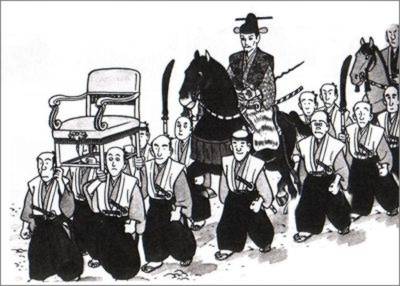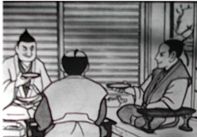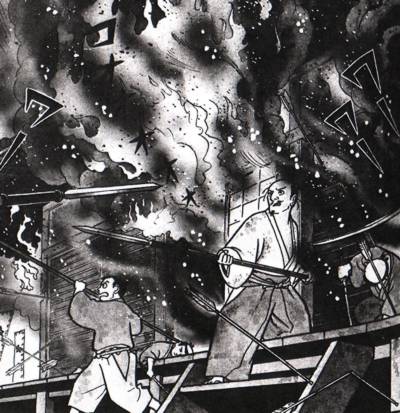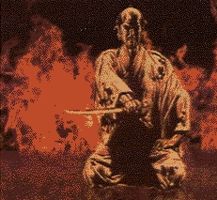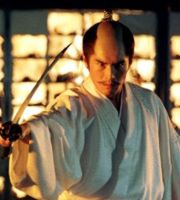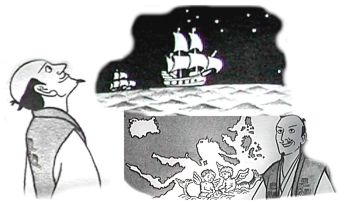HISTORICALLY
CORRECT
PICTURES IN COMIC BOOK OF
THE
LAST MINUTES OF
ODA
NOBUNAGA'S LIFE
This comic book
visualization of Oda Nobunaga's death is most historically-correct,
based on real existing records and chronicles of the Oda clan itself.
It's authorized by the clan and the official Oda Nobunaga museum of Gifu.
The following pictures show the chronology of events before and on June 21, 1582.
Oda Nobunaga, his 14 years-old son Oda Katsunaga, and a very small escort -- between 30 and 50 soldiers, plus servants and valets and his favorite Italian Renaissance chair -- arrived in Kyoto in mid-June. His schedules contained a formal audience with Emperor Ogimachi (that's why he dresses up in court robe in the picture above), and a strategic meeting with Tokugawa Ieyasu concerning the plans of his war in Western Japan. Toyotomi Hideyoshi, Maeda Toshiie and Shibata Katsuie were, at the time, fighting hard around the inner defense of the Mori clan's. It's been a very long campaign, but by New Year everything had seemed better, and now it looked like the Moris would get beaten at last. Oda and Tokugawa needed to discuss the next moves. Saying that he was tired of the splendor of Azuchi, Oda Nobunaga chose to stay at the simple Honno temple. General Oda Nobutada arrived shortly afterwards with his own small band of bodyguards and his uncle Oda Nobutoshi, Nobunaga's younger brother. They went straight to the usual resting place for the Oda clan whenever they were in Kyoto, the Nijo palace. |
| In the picture above, Oda Nobunaga was having some fun riding around the edges of Kyoto on June 19, accompanied by Oda Katsunaga and the Mori boys -- Mori Ranmaru and his little brothers Mori Nagataka and Mori Nagauji, which were still under 15 years old. The Mori boys were all Oda Nobunaga's valets after their father Mori Yoshinari died and their mom Mori Myoko became a Buddhist nun (click here for story and pictures). |
Oda Nobunaga spent the evening of June 20, 1582, chatting with Oda Nobutada, Governor of Kyoto Murai Nagato, and some of his personal acquaintances -- all of whom were civilians, mostly mobile merchants in export-import biz. Oda loved to listen to travel stories. They stayed up until very late. Among his guests that evening was the rich merchant of Sakai, Imai Sokyu (1521-1591) and his son Sokun. They shared the same hobbies with Oda Nobunaga, as long as it doesn't involve weapons; the Imais were noted tea masters and collectors of all sorts of trinkets that Oda Nobunaga also loved to do. Imai had been Oda's supporters since late 1570's, and they had been having a mutually beneficial business relationship besides being personal (sort of) friends. Imai secured the tradesmen's town Sakai for Oda, and got Oda's firearm factory under his management in return. According to folktale, Oda Nobutada remarked on how his dad seemed to have been a 'maniac' when it came to tarts and European cakes, and Oda Nobunaga said he couldn't possibly have them in a few days, for he planned to go straight to the front line of Toyotomi Hideyoshi's in Western Japan. Toyotomi and Kuroda Kanbei had been waiting for him and/or Oda Nobutada to lead an extra army and help them ending the long and difficult siege of Miki castle (click here for story and pictures). When they parted after midnight, Oda Nobunaga reminded Imai Sokyu to deliver the tea-set that he promised to bargain with Oda about, while Imai told him he wouldn't part with it unless Oda was willing to swap the tea-set with one of his favorite paintings. |
Oda Nobunaga woke up around 5:30 on June 21, 1582. He always slept very little and habitually an early riser, though the monks and such had woken up even earlier than Oda's household in whichever castle he ever had. Yet they didn't suspect anything -- because Akechi Mitsuhide's attack was surely unpredictable. Even if someone saw the Akechi clan's army marching near Kyoto at daybreak, they would have assumed that Mitsuhide was only going to see Oda Nobunaga before departing for the 'Western Provinces' where he was supposed to go to. Akechi Mitsuhide had prevented the whole of his cloistered little world from letting the news of his betrayal leak. He gave specific orders to the Akechi clan's scouts to kill everybody on their way, nevermind that they were only farmers and such, that used to rise at dawn everyday. Akechi's own army never knew that they were going to attempt a coup and assassinate Oda Nobunaga. Not even when they were told to rest way before it was time to. Confusion only started to spread among the Akechi soldiers when their sergeants (who were as bewildered and confused as they were) gave orders to discard everything except guns, swords, lances and matches. When some of them dared to ask why on earth they got to leave all their (equivalent of today's) provisional backpack, while the way to the 'Western Provinces' was still far off (click here to see the map), the sergeants of course barked them all into silence. As late as 5 a.m. in the morning, only Akechi Mitsuhide, his reluctantly-tagging-along cousin Akechi Mitsuharu, another cousin, Akechi Mitsutada, and Mitsuhide's Generals like Saito Toshimitsu, Fujita Dengo, Amano Genemon, and Yomoda Masataka, knew what they were about to do. Everyone else only heard about it after they actually entered Kyoto. The Akechi Generals and Mitsuhide's relatives had been asked to swear secrecy a week before, an oath which, had they declined to give, would have caused their death instantly. Even Lord Akechi Mitsuharu of Sakamoto, the cousin who tried in vain to dissuade Mitsuhide from the plan, did so surrounded by Mitsuhide's assassins ready to strike him if he refused. All the scrupulousness wasn't really necessary when it came to Oda Nobunaga -- he didn't see it coming, and his men didn't, either, because they saw Akechi Mitsuhide as an unquestionable 'intellectual' character and -- practically-speaking -- Oda Nobunaga never resorted to his 'Central Intelligence Agency' unless absolutely no other way existed. But Tokugawa Ieyasu was on his way to meet with Oda Nobunaga, that same morning. Akechi Mitsuhide planned to kill him, too, and he had to keep the biz in total hush-hush because Tokugawa always had a ninja corps around him anywhere he went to. Despite Akechi Mitsuhide's carefulness in guarding his secret, the famous Tokugawa ninjas found it out at the last minute and so Tokugawa was saved. Hattori Hanzo and his Koga clan of ninjas managed to take Tokugawa back to his own castle in Mikawa, although the Tokugawas lost quite a chunk of soldiers fighting against Akechi Mitsuhide's lookouts and ambushers. Once safely home, Tokugawa Ieyasu sent messengers to his local allies and vassals, telling them to prepare their armies. He planned to fight against Akechi Mitsuhide. But he couldn't initiate such a battle of revenge for Oda Nobunaga's death, because according to the custom it must be led and started by Oda Nobunaga's own relative. Toyotomi Hideyoshi brushed this convention aside, but Tokugawa considered himself an outsider in this matter, so he only get ready to wage war but before he finished the prep Toyotomi had already defeated Akechi (click here for story and pictures of the battle). |
When the fightings broke up at 6, Governor Murai Nagato woke up, still having a hangover from last night, and asked his guards what the heck was going on. "Probably some drunken ronins, Sir," replied the guards. Murai went back to sleep. He was asked to get out of bed only after fire had started to consume Honno temple, at which point he ran out of his mansion and tried to break through the Akechi human wall, but failed, and his guards died in vain there. Murai decided that Oda Nobunaga must have been dead already, and ran toward the Nijo palace to see if he still could save Oda Nobutada, but the place was blocked by Akechi soldiers, too. So he came back to the governor's mansion and concentrated his soldiers on Imperial buildings. He also dispatched messengers to relay the news of Akechi's attack to Lord Niwa Nagahide in Azuchi, Lord Shibata Katsuie in Echizen, Lord Kambei (Oda) Nobutaka and Lord Kitabatake (Oda) Nobuo in Ise. But Murai's messengers reached their destinations much too late, because they were official messengers of the Oda clan, and were recognizable by everybody, hence they were detained by the Akechi soldiers. Some of them died fighting their way thru, and some had to get back to Murai's mansion and reported that they couldn't even get out of the city. In separate houses in town, whose gates were locked tight since Akechi soldiers spared no one, Oda Nobunaga's civilian buddies wrote about the attack and at the first chance to do so they sent messengers to everybody they knew. These messengers found it easier to pass Akechi's barricade because they knew every back alley in town and they were at any rate not belonging to the Oda clan. One of these civilian messengers, sent by a Kyotoite merchant (or Imai Sokyu, nobody knew which), reached Toyotomi Hideyoshi's camp far away in Western Japan in just a single day, a miracle already in speed even if we don't consider how tight Akechi's barricade around Kyoto was. When the fighting had been going on for two hours or so, Oda Nobunaga knew his time had come. Fire, lit by Akechi soldiers, had spread to the innermost chambers of the Honno temple, and the bodies of Oda's minimum escort, the monks, the apprentices and lay-priests of the Honno temple, Oda's African slave, the younger Mori brothers (all were under 15 years old), were testimonies of this no-way-out situation. His own son Oda Katsunaga had died, too. Oda Nobunaga fought with an archery set, using Akechi archers' spoils (those directed at Oda but missed the target). His bowstring snapped at last, and he snatched a lance from an Akechi soldier. But at last he retreated because an arrow pierced his arm.
Oda
Nobunaga's 'seppuku' in a history book, 1998 (left), and Click here for the variety of 'seppuku' in samurai history.
And he committed suicide in his bedroom of the previous night, after asking Mori Ranmaru to burn his body so that no Akechi soldier would be able to claim his head. The first Akechi soldiers who broke into the last burning wall of the next room reported that they heard Oda Nobunaga's last words: "No regret!" All this was over some time after noon. In Nijo palace, no one was left of the Odas. Oda Nobutada was no more, so was his uncle. Also died in the fightings the young Captain Fukutomi Hidekatsu, one of the Odas' best gunners, who did a really good job in the Nagashino battle of 1575. Captain Sugaya Nagayori (1555-1582) of Oda Nobutada's own army died there, too. The only survivor of this betrayal, Oda Nobunaga's newly-appointed Civil Deputy for the capital city, Maeda Geni, was found somewhere in the outskirt by local peasants by nightfall, full of burnts and soot, exhausted from fighting his way out of the temporary inferno. The next day, all that Oda Nobunaga's sons could find was their daddy's war-helmet, badly burnt but still functional. They took this to Oda Nobunaga's private temple in Gifu. (Click here for pictures). |
Oda Nobunaga's
dream of sailing across the ocean --
"when I have retired from war," he said to Imai Sokyu --
stayed a pie in the smokey Kyoto sky.
NEXT
PAGE :
REAL PLACE OF ODA NOBUNAGA'S DEATH
